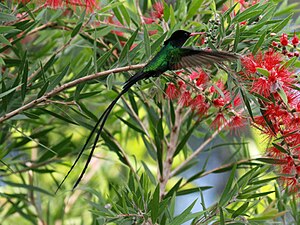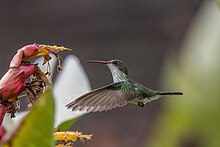Pennant tail
| Pennant tail | ||||||||||
|---|---|---|---|---|---|---|---|---|---|---|

Pennant tail ( Trochilus polytmus ), male |
||||||||||
| Systematics | ||||||||||
|
||||||||||
| Scientific name | ||||||||||
| Trochilus polytmus | ||||||||||
| Linnaeus , 1758 |
The pennant tail ( Trochilus polytmus ), also known as the Jamaican hummingbird or red-billed Jamaican sylphe , is a hummingbird that only occurs in Jamaica . There he is also called Doctor Bird .
features
Pennant tail males can be recognized by their dark, up to 17 cm long tail feathers and the green, black and blue iridescent plumage . Its long beak is bright red. The head-torso length is usually 25 cm and their weight is five grams. The female is smaller, has a dark red to brown beak and a white underside, while the back and head are brown in color. Pennant tails flap their wings about 30 to 75 times a second . The male is accompanied by a loud buzzing sound in flight, as the air flowing past sets the tail feathers in motion . Your ringing tone is a loud "tie-tie-tei".
Way of life
The Jamaican hummingbirds are indigenous to their island everywhere, but they prefer to stay in clear areas at sea level. They are very territorial and defend their territories with their pointed beaks against any bird that tries to invade their area. Despite its long tail feathers, the male can fly very well. As soon as it lands, however, the bird looks relatively clumsy. The pennant tail can save energy by falling into the torpor (state of rigidity), adapting its body temperature to its surroundings. This slows down the vital functions to a minimum.
Courtship and breeding biology
In the breeding season , which usually takes place before or after the rainy season (October or May), the males gather in small groups and try to attract the females' attention with their iridescent colors . After mating , the female gathers threads, cotton , hair , ferns, and sticky spider webs to build the nest. There she lays two white, elongated eggs , which she incubates for 14 to 19 days. Once the young have hatched, the female has to get a lot of food for the young. As soon as it has gathered enough, it will return to the nest and choke the food straight into the throats of the young birds . During the first few days the female still cleans the nest of the droppings , but after a short time the chicks learn to do it themselves. The nestling period is three to four weeks, after which the young are fledged and leave the nest. Sometimes the female mates again immediately afterwards, so that it breeds twice in a year.
nutrition
The pennant tails mainly feed on nectar , which they pull from the flower crowns with their tongue . You cannot land on the flowers, as they are usually so tender that they would break off. That is why they "stand" in their soaring flight directly in front of the flower and dip their beak into it. Sometimes they also eat insects , which are difficult to hunt and digest.
Spread and threat
Pennant tails are only found in Jamaica , the third largest island in the Greater Antilles. Their stock is relatively stable; they even benefit from the deforestation of the rainforest, as they can find their way better in the open country.
In 1901 , another species was discovered that only occurs in eastern Jamaica and has a black beak: the black-billed pennant tail ( Trochilus scitulus ) is referred to by some experts as a subspecies of the pennant tail.
Etymology and history of research
Carl von Linné described the hummingbird under the current name Trochilus Polytmus . He named America as the site. With the species he also introduced the generic name »Trochilus« into science. This name is a bit of a problem historically. It was already used by Aristotle for a bird that visits the mouth of a crocodile without being injured or even eaten by it. Étienne Geoffroy Saint-Hilaire suspected that Aristotle used it to describe the crocodile guardian ( Pluvianus aegyptius ). Nevertheless, it has become common among scientists to use this term in connection with hummingbirds. "Polytmus" is derived from the Greek "polytimos πολυτιμος " for "very precious, valuable". This in turn is made up of "polys πολυς " for "a lot" and "timē τιμη " for "value, esteem".
literature
- Helmut Folger: Hummingbirds. Your way of life and attitude . Eugen Ulmer Verlag, Stuttgart 1982, ISBN 978-3-8001-7073-9 .
- James A. Jobling: Helm Dictionary of Scientific Bird Names . Christopher Helm, London 2010, ISBN 978-1-4081-2501-4 .
- Carl von Linné: Systema Naturae per Regna Tria Naturae, Secundum Classes, Ordines, Genera, Species, Cum Characteribus, Differentiis, Synonymis, Locis . 10th edition. tape 1 . Imprensis Direct Laurentii Salvii, Stockholm 1758 ( biodiversitylibrary.org ).
- Étienne Geoffroy Saint-Hilaire: Mémoire sur deux espèces d'animaux nommés Trochilus et Bdella par Hérodote, leur guerre, et la part qu'y prend le Crocodile . In: Mémoires du Muséum d'histoire naturelle . tape 15 , 1827, pp. 459-474 ( biodiversitylibrary.org ).
Web links
- Trochilus polytmus inthe IUCN Red List of Threatened Species 2014.2. Listed by: BirdLife International, 2012. Retrieved August 23, 2014.
- BirdLife International: Species Factsheet - Red-billed Streamertail ( Trochilus polytmus ) . Retrieved August 23, 2014.
- Videos, photos and sound recordings for Red-billed Streamertail (Trochilus polytmus) in the Internet Bird Collection
- Red-billed Jamaican sylph ( Trochilus polytmus ) at Avibase; accessed on August 23, 2014.
- Trochilus polytmus in the Integrated Taxonomic Information System (ITIS)
- xeno-canto: Sound recordings - Red-billed Streamertail ( Trochilus polytmus )
- Red-billed Jamaican sylphe (Trochilus polytmus) in the Encyclopedia of Life . Retrieved July 27, 2018.

